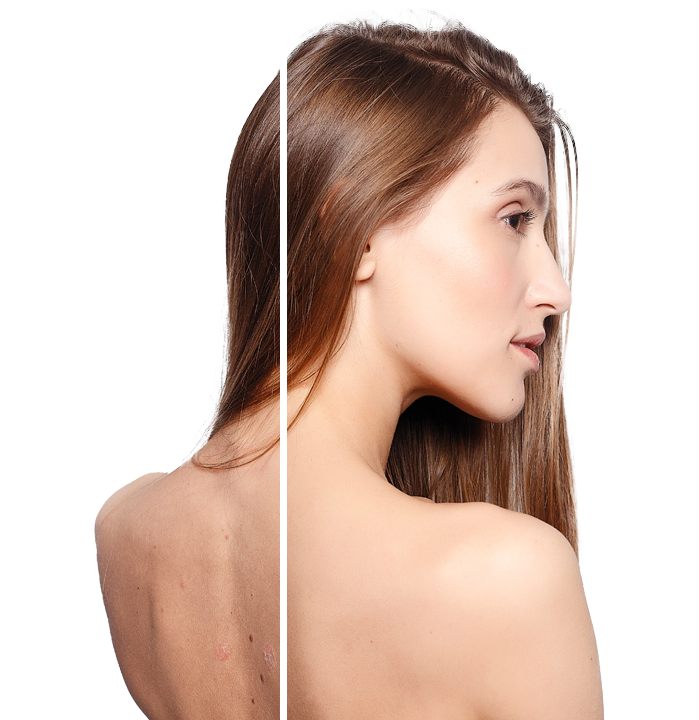Dermato Surgery
Specialisation

Embark on a journey to skin wellness with our expert dermatosurgery services at Tricare Clinic. Our dermato surgical procedures encompass a range of solutions, from cyst and corn excisions to specialized treatments like earlobe repair, vitiligo surgery, keloid excision, intralesional radiofrequency, and the removal of moles, warts, and skin tags.
Dermato Surgery
Specialisation


Embark on a journey to skin wellness with our expert dermatosurgery services at Tricare Clinic. Our dermato surgical procedures encompass a range of solutions, from cyst and corn excisions to specialized treatments like earlobe repair, vitiligo surgery, keloid excision, intralesional radiofrequency, and the removal of moles, warts, and skin tags.

Dermato Surgery Specialisation:
1. Earlobe Repair:
Piercings have been a popular way to adorn the ears with various types of jewelry and ornaments across the globe. However, sometimes heavy earrings or prolonged usage can lead to complications, resulting in the need for a repair. Earlobe repair is a simple and safe daycare procedure that can effectively restore the earlobe, allowing you to get your piercing done again.
The procedure typically takes around 30 to 60 minutes and is quick, easy, and painless. It provides you with a cosmetically acceptable and strong scar. During the procedure, the area is cleaned, and a local anesthetic is injected to minimize discomfort. The skin inside the edge of the large hole is carefully removed, preserving the natural contour of the ear. The front and back of the earlobe are then approximated with fine stitches, and a small dressing is placed over the area.
After the surgery, the stitches are removed around seventh day, and earrings should be avoided for three months. This will allow the ear to heal properly and prevent any complications. Overall, earlobe repair is an excellent option for those who want to restore their piercing and enjoy wearing their favourite earrings and ornaments once again.
2. Keloid Excision:
Keloids are a type of abnormal scarring that can occur in people of different races. They can have significant aesthetic consequences and cause distress to those who have them. Keloids are characterized by the abnormal proliferation of scar tissue at the site of injury, particularly after a trauma or surgery.
Unlike normal scars, keloids grow beyond the margin of the original wound and do not regress over time. There are numerous therapeutic options available for the treatment of keloids. These include surgical intervention, pressure therapy, cryotherapy, laser treatment, intralesional corticosteroids, and radiation.
However, the effectiveness of these treatments can vary depending on the size and severity of the keloid. In some cases, large keloids may require surgical debulking, which involves the removal of a significant portion of the scar tissue. Keloid excision surgery is a common treatment option for keloids. However, it requires careful planning and execution to achieve the desired results. Surgical skills are essential to ensure that the surgery is effective and reduces the chance of recurrence.
The goal of keloid excision surgery is to remove the bulk of the scar tissue while minimizing scarring and ensuring that the keloid does not reoccur.
3. Cyst Excision:
There are various types of cysts, including sebaceous cysts, pilar cysts, and steatocystoma, among others. These cysts can present as simple lesions, but they may be accompanied by different symptoms. They are most commonly found on the trunk, neck, face, scrotum, and other areas of the body.
Cysts usually grow slowly and are generally asymptomatic, but sometimes they may cause pain or discomfort. In such cases, various surgical approaches can be used for their removal. One of the most common methods used is complete surgical excision, which involves removing the cyst and its sac to prevent recurrence.
This approach is considered the most effective and is generally preferred for larger cysts. Another less invasive technique that can be used is the narrow whole extrusion technique. This method involves making small incisions to extract the cyst contents and usually takes around 30 to 60 minutes to complete.
The procedure is performed under local anaesthesia and ensure maximum precision and safety. Overall, the choice of surgical approach will depend on various factors such as the size and location of the cyst, as well as the patient’s overall health and medical history.
It is essential to discuss the best options with a qualified healthcare professional to determine the most appropriate treatment plan.
